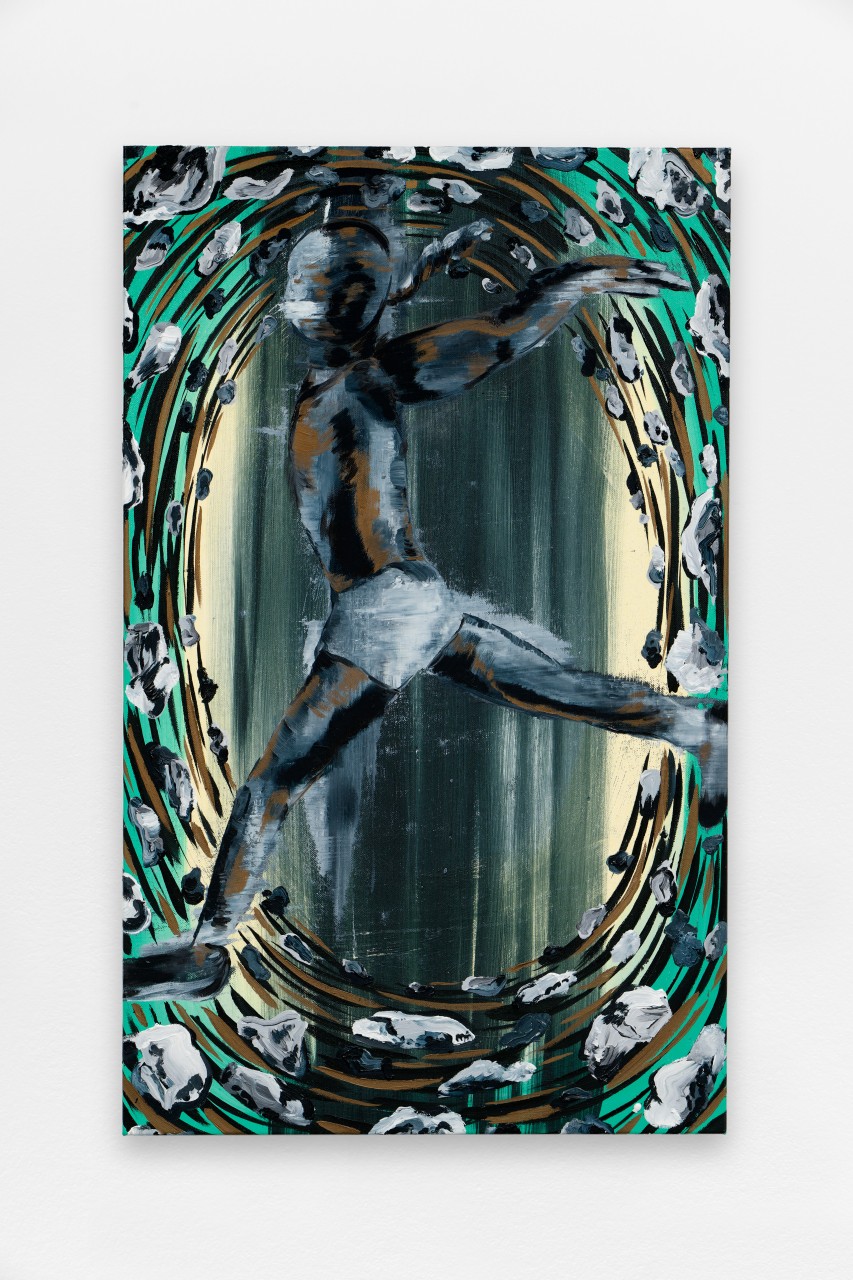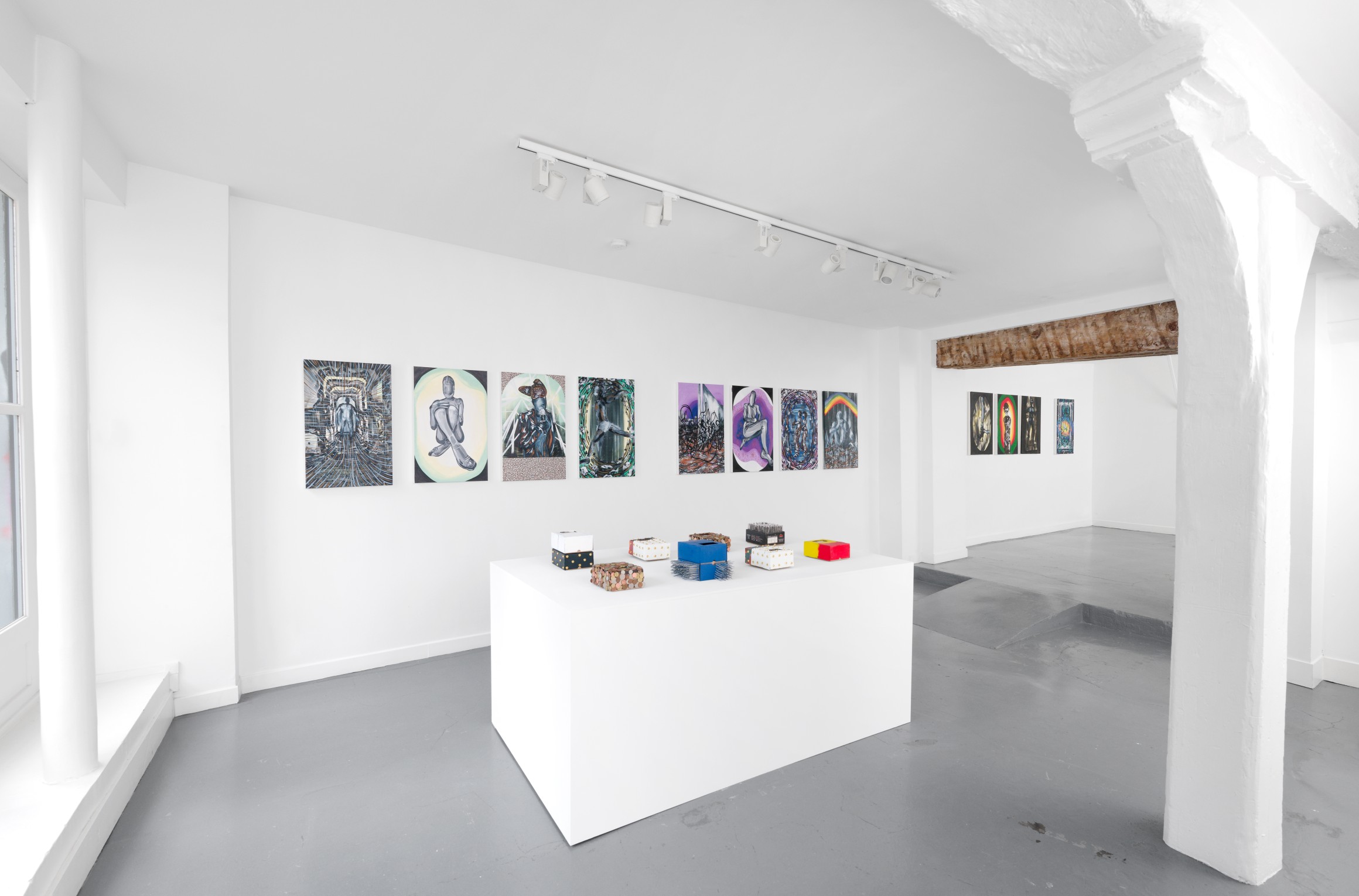- Talk Gaby Sahhar & Martha Kirszenbaum


French and British artist of Palestinian origin, Gaby Sahhar explores themes related to the notion of borders, political geographies, gender identities, and sexuality in their paintings, sculptures, and installations. Drawing on speculative fiction, science fiction, and reflections on transit sites in Western metropolises, they weave narratives aimed at deconstructing the power dynamics imposed on marginalized communities, particularly queer ones, by focusing on intersectionality and the potential encounters between different activist practices.
Their work has been exhibited at: Magasins Généraux, Pantin (2024); Institut du Monde Arabe, Paris (2024); Quench, Margate, UK (2024) ; MAC VAL, Paris / The Kooples Art Prize (2023); PAGE (NYC), New York (2022); SPACE Artist Award (2022); Fragment Gallery, New York (2022); Sadie Coles HQ, Londres (2022), Whitechapel Gallery (2022) South London Gallery (2020).
Martha Kirszenbaum is a curator, writer and editor based in Paris. She graduated from Sciences-Po in Paris and Columbia University in New York with an M.A. in Political History and Cultural Studies. Kirszenbaum was the Curator of the French Pavilion of the 58th Venice Biennale represented by Laure Prouvost. She founded and directed Fahrenheit, an exhibition space and residency program in Los Angeles (2014-17). Previously she acted as the Associate Curator at the Kunsthalle Mulhouse (2014) and as Curator-in-Residence at the Belvedere Museum/21er Haus in Vienna (2012) and at the Center for Contemporary Art in Warsaw (2010). She also held positions at the New Museum in New York (2008-10), the Photography Department of Centre Georges Pompidou in Paris (2007) and the Media Department of MoMA in New York (2006-07). More recently she acted as the Associate Artistic Director of the Mediterranean project of Art Explora Foundation and as Associate Chief Curator at Kistefos Museum, Norway.
Kirszenbaum has organized exhibitions, screenings, performances and talks at renowned international institutions such as the ICA London, Palais de Tokyo in Paris, Madre Museum in Naples, National Museum of Oslo, Kunstall Stavanger, Beirut Art Center, Fondation Ricard in Paris, Kadist Paris and San Francisco, Pejman Foundation in Tehran, 221A in Vancouver, Los Angeles Contemporary Exhibitions, Marrakech Biennale and Istanbul Biennale. She is a regular contributor to Flash Art, Mousse, Kaleidoscope and CURA where she sits on the editorial board, and has led seminars at UCLA, Université Paris VIII, Malmö Art Academy. She served on the jury for the Pinchuk Future Generation Art Prize, Herb Alpert Award, Jan Van Eyck Academy, Rencontres d’Arles Prix Découverte, Cité Internationale des Arts, and sits on the Advisory Board of Tselinny Art Center in Almaty, Kazakhstan.

Exhibition View, « When language fails, bodies talk », spiaggia libera, Paris, France, 2024. Photo © Aurélien Mole
” In his essay What is a Border? (1994), philosopher Etienne Balibar mentions three key aspects of the ambiguity of borders inherited from colonial empires and the concept of the nation-state: their overdetermination, polysemy, and heterogeneity. Theissueofborders,whetherpolitical,colonial,or imaginary, is thus at the heart of Gaby Sahhar’s practice.
The queer body can also be seen as both an intimate and public border — once bodies are liberated, borders will be too. As writer and scholar Paul B. Preciado often expresses, the body is a true “living political archive,” and its stigmas reflect the events and traumas of the time we live in.
Inspired by the architectural politics revealed in the construction of borders — recognizable by their steel structures and metal cubes — Gaby Sahhar evokes in their paintings an environment of fragmented landscapes, a border- like division of walls and gates, perhaps those that have enclosed Palestinian territories since 2002. Gaby Sahhar’s latest series of paintings presents a psychedelic aesthetic with green, red, and black tones, further evoking the colors of the Palestinian, French, and British flags.

Concrete Jump, 2024, oil on linen, 75 x 45 cm. Courtesy the artist & spiaggia libera, Paris. Photo © Aurélien Mole

Gaby Sahhar, Distorted, 2024 Huile sur lin , 75 × 45 cm. Courtesy the artist & spiaggia libera, Paris.
A set of eight sculptures punctuates the exhibition, made from Palestinian Medjool date boxes. All are adorned with elements related to the notion of borders, standing as vernacular remnants of how Palestinian culture has managed to cross borders into Western Europe.
It is precisely the forbidden architectures and blurred peripheries of borders—hostile and violent environments often arranged by colonial powers—that seem to fascinate the artist, whose works reflect in their own way the theories of the Forensic Architecture movement (Border Forensic), a multidisciplinary research group based in London using architectural techniques and technologies to investigate cases of state violence and human rights violations worldwide.
The titles of Gaby Sahhar’s works seem to come straight from a border identity check, questioning the deprivation of our rights in these moments of power and humiliation: Passport Please, Enforcement Shoe, Suspicious Item, etc. It is, moreover, the fantasy of these borders that they have not known and cannot visit that gives their paintings their somewhat unsettling semi-fictional aspect.

Vue d’exposition, « When language fails, bodies talk », spiaggia libera, Paris, France, 2024. Photo © Aurélien Mole
One of the artist’s tutelary figures is Pierre Molinier, a painter and photographer from the early last century, whose life and work are filled with dark fantasies and sensational anecdotes. His photographs of fetishized bodies remain captivating today.
Although inspired by Surrealism, Molinier remained on the fringes of the movement. His self-portrait technique, to which Gaby Sahhar refers, involved photographing himself crossdressed and made up, then cutting and reassembling the images to create a collage — an idealized vision of himself. Gaby Sahhar’s paintings depict androgynous creatures, part-robotic and part-fetish, with hidden faces, proposing an alternative existence to heterosexual conventions. Not only complex in their technique and subject matter, their figures, like those of Molinier, challenge traditional ideas of power, domination, and gender fluidity.

Compressed memories, 2024, Oil on linen, 75 x 55 cm. Courtesy the artist & spiaggia libera, Paris. Photo © Aurélien Mole
Icons of a post-gender era and a pioneer of queer culture, Molinier left behind a space for young artists like Gaby Sahhar to imagine new visual and political possibilities. Like other painters to whom the artist echoes, Molinier explores the fragmentation of the human body, shattering its contours to reveal a new vision.
This transgressive and deeply symbolic deconstruction reflects the fragmentation of borders in a world at war, where perhaps only fragmented bodies can still be represented. When language fails, bodies talk.
Martha Kirszenbaum

Vue d’exposition, « When language fails, bodies talk », spiaggia libera, Paris, France, 2024. Photo © Aurélien Mole

Gaby Sahhar, The Impossible , 2024, Oil on linen, 75 × 45 cm. Courtesy the artist & spiaggia libera, Paris. Photo © Aurélien Mole

Gaby Sahhar, Untitled, 2024, Oil on linen, 75 × 45 cm. Courtesy the artist & spiaggia libera, Paris. Photo © Aurélien Mole









